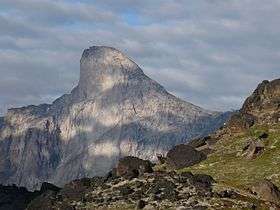Mount Thor
| Mount Thor | |
|---|---|
| Thor Peak | |
 Mount Thor seen from Akshayuk Pass | |
| Highest point | |
| Elevation | 1,675 m (5,495 ft) [1] |
| Coordinates | 66°32′00″N 65°19′00″W / 66.53330°N 65.31670°WCoordinates: 66°32′00″N 65°19′00″W / 66.53330°N 65.31670°W [1] |
| Geography | |
| Parent range | Baffin Mountains |
| Topo map | NTS 026.I.11 |
| Climbing | |
| First ascent | Morton and Spitzer, 1965 |
Mount Thor, officially gazetted as Thor Peak, is a mountain with an elevation of 1,675 metres (5,495 ft) located in Auyuittuq National Park, on Baffin Island, Nunavut, Canada. The mountain is located 46 km (29 mi) northeast of Pangnirtung and features Earth's greatest vertical drop of 1,250 m (4,101 ft), with the cliff overhanging at an average angle of 15 degrees from vertical.[2] Despite its remoteness, this feature makes the mountain a popular rock climbing site. Camping is allowed, with the only official site being at the entrance to the Akshayuk Valley near Overlord Peak.
The mountain was named for Thor, the Norse thunder god.[3]
Geography
Mount Thor is part of the Baffin Mountains which in turn form part of the Arctic Cordillera mountain range. The mountain consists of granite.[1]
 View of Mount Thor summit in 1997 |
 Mount Thor and its steep cliff |
Hiking north towards Thor Peak, July 2007. |
Ascents
Donald Morton and Lyman Spitzer made the first ascent of Mount Thor in 1965 during the Alpine Club of Canada expedition led by Pat Baird.[4]:347[5] Pat Baird also led the 1953 geophysical expedition during which Hans Weber, J. Rothlisberger and F. Schwarzenbach climbed the North Tower of Mount Asgard for the first time.
A team descended Mount Thor via rappel July 23, 2006. The American team consisted of Chuck Constable, Dirk Siron, Ben Holley, Kenneth Waite, Gordon Rosser, Donny Opperman, Deldon Barfuss, and Tim Hudson. A 26-year-old Canadian national park warden, Philip Robinson, also rappelled, but had a problem with his equipment and died when he fell from the mountain. There had been a previous attempt in 2004, but they returned without rappelling due to dangerous weather conditions.[6] The first rappel of the west face was in July 1982, led by Steve Holmes of Atlanta, using a mile long length of rope. This was at the time the longest rappel (and climb, via rope) ever done.[7]
The first ascent of the west face was achieved by Earl Redfern, John Bagley, Eric Brand and Tom Bepler in 1985.[8] The first solo ascent of the West Face was completed by Jason 'Singer' Smith in 1998. The first free climb of the Southwest Buttress was made in 2012 by Bill Borger and John Furneaux.[9][10]
See also
- Trango Towers, the tallest near-vertical drop on earth.
- Cerro Torre
- Half Dome
References
- 1 2 3 "Thor Peak". Bivouac.com. Retrieved 2009-11-30.
- ↑ "Mount Thor -The Greatest Vertical Drop on Earth!". The Daily Galaxy. March 9, 2010. Retrieved 2014-08-21.
- ↑ Jennings, Ken (10 June 2013). "Meet Canada's Mount Thor: The World's Steepest, Tallest Cliff". Conde Nast Traveler. Retrieved 18 April 2015.
- ↑ Ostriker, J. P. (2007). "Lyman Spitzer. 26 June 1914 -- 31 March 1997: Elected ForMemRS 1990" (PDF). Biographical Memoirs of Fellows of the Royal Society. 53: 339–348. doi:10.1098/rsbm.2007.0020.
- ↑ Canadian Alpine Journal. 49: 28–42. 1966. Missing or empty
|title=(help) - ↑ "Friends, family mourn death of parks officer". Nunatsiaq News. August 11, 2006. Archived from the original on June 12, 2008.
- ↑ TAYLOR, MICHAEL RAY. "Toil and Trouble on Mount Thor". Retrieved 2016-07-25.
- ↑ Redfern, Earl (December 1995), "-Mount Thor - 33 Days on the West Face", Climbing Magazine (93): 34–36, ISSN 0045-7159
- ↑ "Climber Bill Borger". Radio Canada. July 24, 2012. Retrieved 2012-08-28.
- ↑ Hummel, Will (August 3, 2012), "New route on Baffin Island's Mount Thor", Rock and Ice, archived from the original on 2012-08-08, retrieved 2012-08-28
External links
| Wikimedia Commons has media related to Mount Thor. |
- A Dallas Morning News article about Mt. Thor and other Akshayuk Pass features by writer Dave Levinthal
